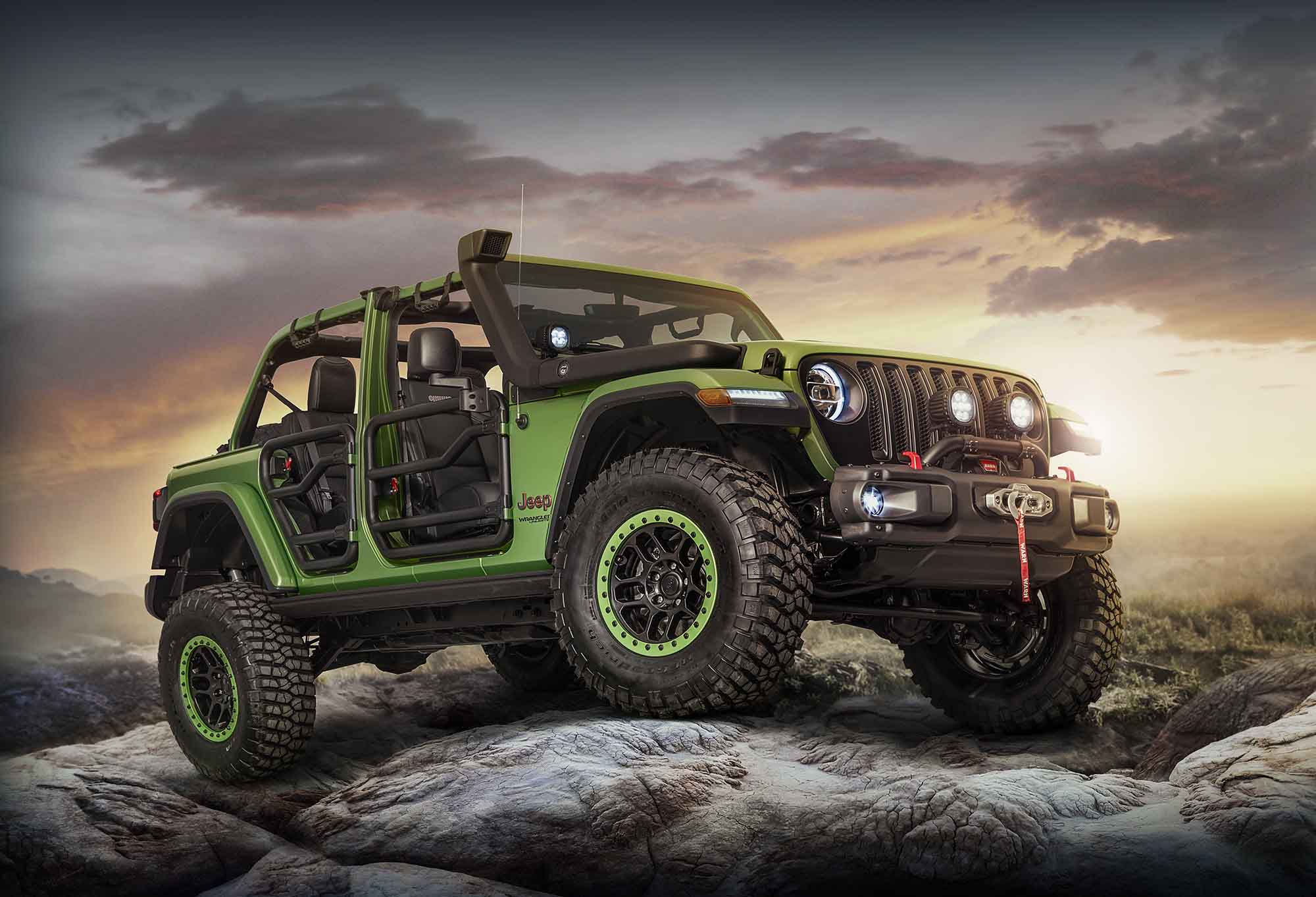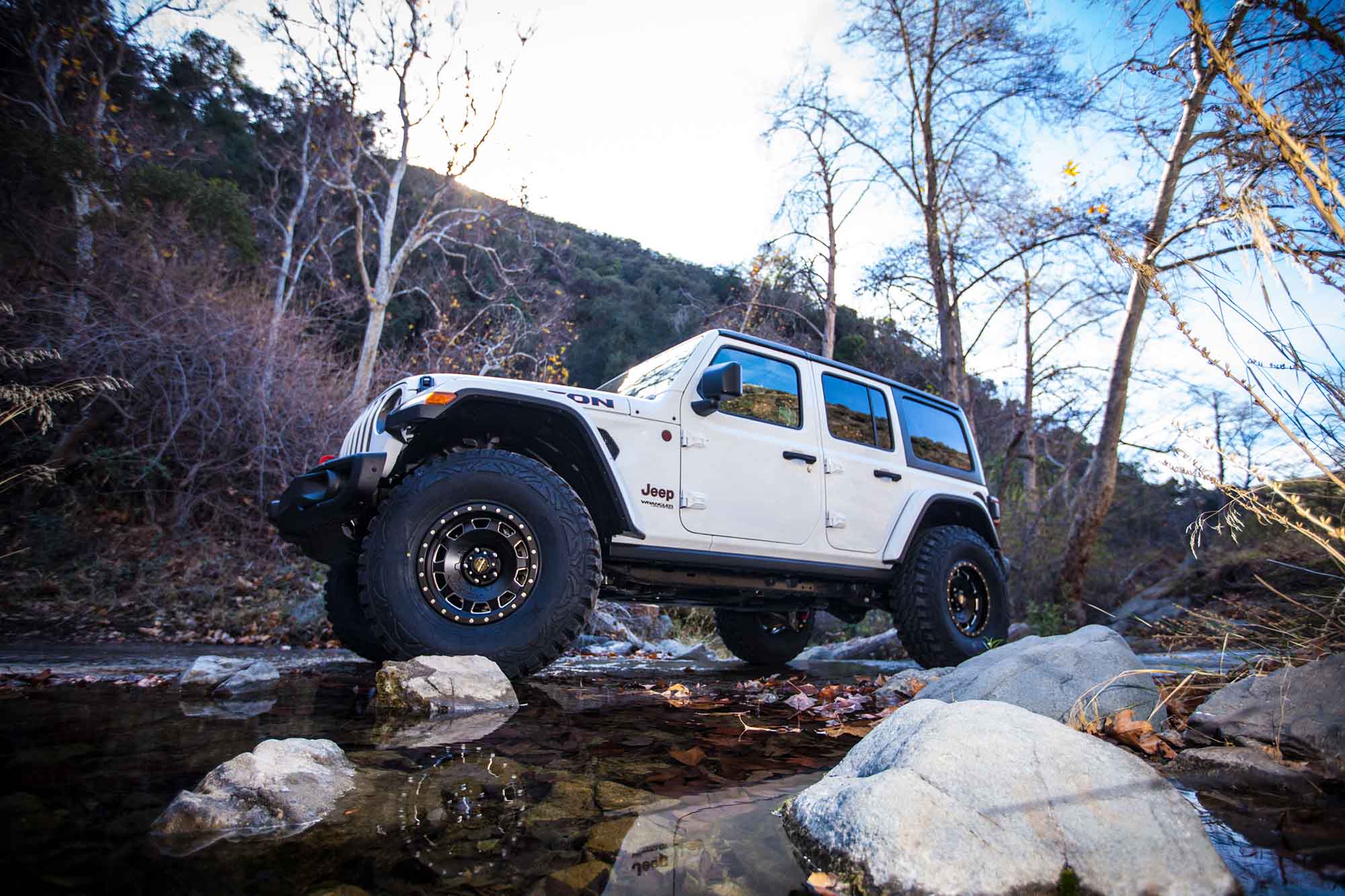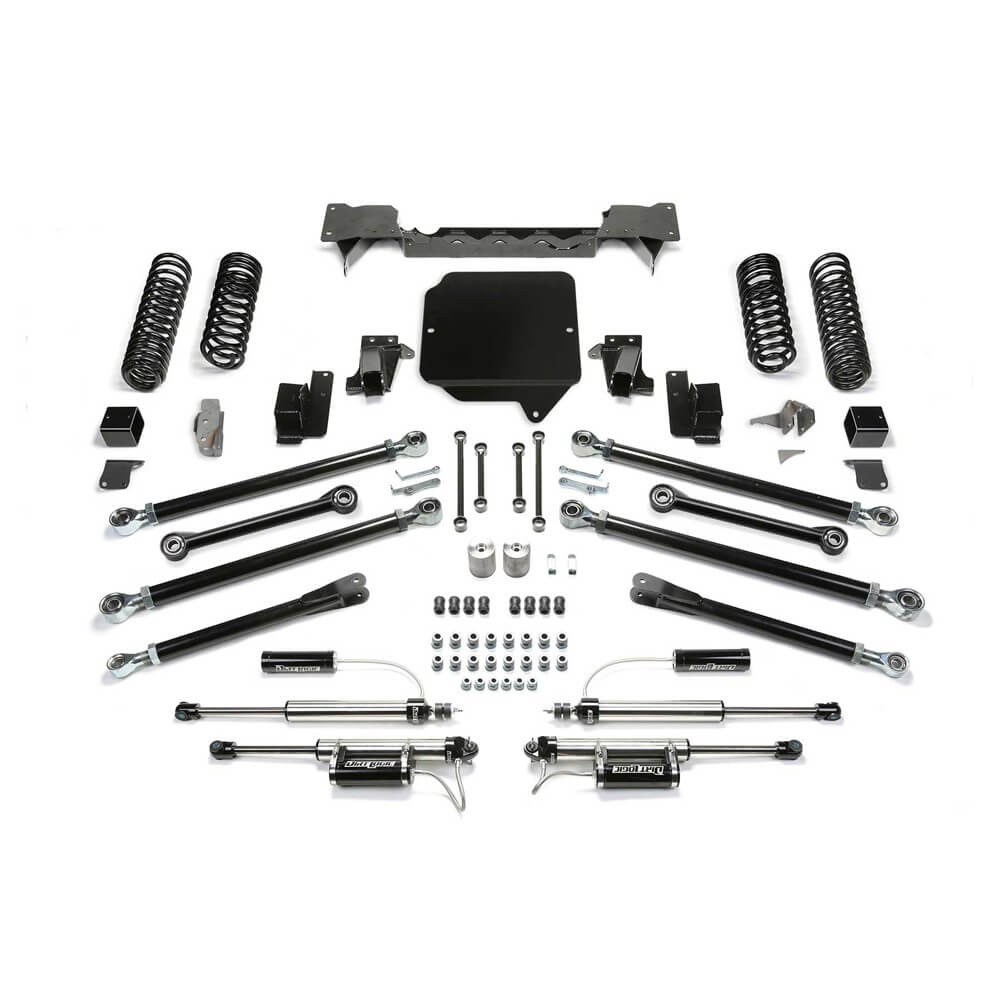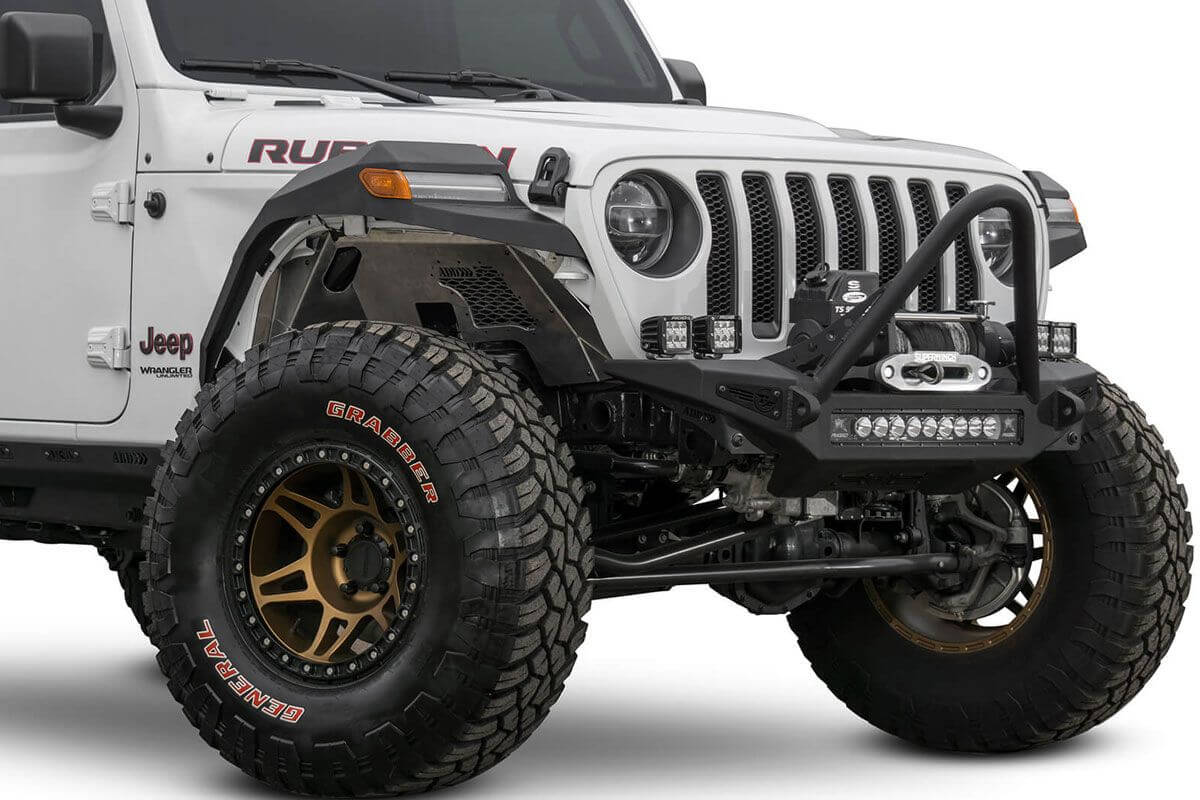
It’s been universally accepted that the 2018-current Jeep JL is a better Wrangler than the 2017-18 JK Wrangler. Beyond the swanky new interior, one of the most notable improvements is the suspension and steering. Much like the rest of the JL, these components are more refined versions of what is found on the JK. The factory JL control arms are longer, the suspension and steering geometry has been improved, and the overall ride of the JL is smoother than the JK. Of course, this already great JL platform can easily be improved on by fitting bigger tires for the trail.
The large wheel openings of the JL allow for a wide range of factory tire and wheel offerings. The Sport, Sahara, and Rubicon JL trim levels all feature different sized wheels and tires. The Sport model comes with 245/75R17 tires, which are 31.5 inches tall. The Sahara model features the same suspension and body bits as a Sport model, but it comes with slightly larger 255/70R18 tires that measure out to about 32 inches in diameter. The JL Rubicon features 285/70R17 tires that measure out to about 33 inches in diameter. To fit the 33-inch tires, the Rubicon trim level comes with wider axles, a moderately different suspension than the Sport and Sahara models, and larger wheel openings thanks to factory raised fender flares. Given these differences, increasing the tire diameter on your Jeep JL will require you to keep your Jeep’s trim level in mind when selecting the correct lift kit height.
The suspension, wider axles, and fender flares with larger wheel openings on the JL Rubicon provide room for the factory 33-inch tires. Fortunately, there are many different aftermarket raised fenders which can be added to the JL Sport and Sahara models for easier fitment of bigger tires.
Fitting 33-inch Tires
Since the JL Rubicon already comes with 33-inch tires from the factory, fitting 33-inch tires is a bolt-on proposition, unless you upgrade to an overly-wide tire and wheel combination. If you are working with a Sport or Sahara model, you have a couple of options when fitting 33-inch tires cleanly. The easiest route is to remove the factory plastic fender flares and replace them with aftermarket raised or high-top fenders, similar to what can be found on the JL Rubicon. Several different aftermarket fender flare versions are available for the JL to meet your styling preferences. Some of the aftermarket flares are even paintable to match the color of your Jeep. You’ll also need to add wheel spacers or select new wheels with backspacing around 4.5 inches. The best part is that the handling and ride of your Jeep will not change with the installation of fender flares. All of the factory suspension components can be retained.
The other option is to install a 1.5- to 2-inch suspension lift with the stock fender flares. This is typically done with coil spacers, which will also retain the factory coils and ride. For those that wish to drive more aggressively, consider going with the 1.5- to 2-inch lift kits that come with new coils and performance shocks.

The JL Rubicon can fit 35-inch tires stock, but if you plan to take it off-road you’ll likely want a 2-inch lift to keep the tires from rubbing. Sport and Sahara models will benefit from the installation of aftermarket high-clearance fender flares at all four corners along with a 1- to 2-inch lift when fitting 35-inch tires.
Fitting 35-inch Tires
You’ll rest easy knowing the Jeep engineers designed the JL Rubicon to handle the stress that 35-inch tires can dish out on- and off-road. The 35-inch tires will fit using the stock Rubicon suspension with minor rubbing if you drive gingerly on the street. For off-road use, you’ll want at least 1-2 inches of lift. To get this amount of lift you can install a coil spacer kit that retains the factory coils and shocks or install all new coils and shocks. As mentioned earlier, a spacer kit will generally ride smoother, which is good if you spend a lot of time on the street. The suspension kits that include new coils and shocks will typically ride slightly firmer and allow for more aggressive driving off-road.
If you have a Sport or Sahara model JL and want 35-inch tires, you could start with the installation of aftermarket raised fender flares and follow up with a 1- to 2-inch lift. Going this route rather than with a bigger suspension lift alone will help avoid more complex suspension modifications. Fitting 35-inch tires while retaining the stock Sport or Sahara fender flares will require the use of a 2- to 3-inch lift. If you use your Sport or Sahara aggressively off-road with 35-inch tires, you should consider upgrading the Dana 30 front axle assembly.

Fitting 37-inch tires on a JL Rubicon is not a difficult task. It doesn’t take much more than proper bump stops and a 2-inch lift. However, keeping the stock axle assemblies alive will take some restraint when driving off-road since the axles will be at their operational limits with these tires.
Fitting 37-inch Tires
Stepping into 37-inch tires usually means you are interested in some more serious trails. The Rubicon JL can fit 37-inch tires with a 2- to 3-inch lift and properly located bump stops, but the axle assemblies will be at their operational limit. Sure, you can keep the stock Rubicon axles alive with 37-inch tires on mild trails and mostly street use, but hitting more challenging trails with a JL Rubicon on 37-inch tires will eventually require aftermarket axle upgrades or an entire axle assembly swap.
The JL Sport and Sahara models will fit 37-inch tires with the use of raised aftermarket fender flares and a 2- to 3-inch lift with the correct bump stops. The smaller non-Rubicon Dana 30 front axle assembly in these Jeeps could potentially be a problem off-road with 37-inch tires. You’ll want to drive gracefully or swap out the assembly for something beefier.
High-performance long-travel 3-inch and taller lift systems may require replacement of the OE CV-style driveshafts with traditional U-joint driveshafts. The wheel backspacing you need will depend on the lift kit you choose and the width of the tires. Some lift and tire combinations will require wheels with 4.5 inches of backspacing. Others can get away with almost 6 inches of backspacing.
Replacing the factory suspension parts with a 2-inch lift that comes with new coils and shocks will typically allow for more aggressive driving off-road. Most coil spring lift kits come with sway bar extensions and longer lower control arms or control arm relocation brackets to correct front axle caster.
A simple coil spacer kit, such as this one from Rubicon Express offers 2 inches of lift without dramatically altering the ride and handling of your Jeep JL. The factory shocks and coil springs are retained. Coil spacer kits are one of the most popular suspension lifts for the Jeep JL.
Fitting 40-inch Tires
If you’re fitting 40-inch tires on your JL you’re probably sticking to the street, have budgeted 1-ton front and rear axles into your off-road build plan, or you’re simply throwing caution into the wind and praying your front and rear axle assemblies survive off-road. The use of 40-inch tires is best done by building the Jeep around the tires, rather than fitting the tires to the Jeep. To fit 40-inch tires, you’ll be in 5- to 6-inch lift kit territory with properly located bump stops and either Rubicon or aftermarket raised fender flares. Shorter lifts can be used, but you’ll need to pay special attention to bump stop location and significantly chop and modify the fender openings for tire clearance at full suspension compression. Consider beefier driveshafts mandatory when installing 40-inch tires, especially if installing a high-performance long-travel suspension system. Wider aftermarket wheels with around 4.5 inches of backspacing will be required in most cases.





2